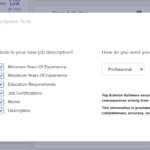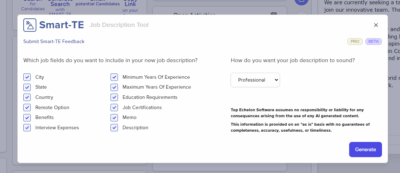In the competitive world of recruitment, agency recruiters and search consultants are constantly seeking ways to enhance their effectiveness, broaden their reach, and ultimately increase their revenue. One powerful strategy to achieve these goals is participating in a split placement network.
This approach involves collaborating with other recruiters to fill job orders, where both parties share the placement fee. While some recruiters may hesitate at the thought of splitting their commission, the benefits of this collaborative method can far outweigh the drawbacks.
This article from Top Echelon Software explores how and why working with other recruiters in a split placement network can help you generate more revenue, delving into the mechanics of split placements, their advantages, and best practices for successful collaboration.
Understanding Split Placement Networks
Definition and Overview
A split placement network is a collaborative arrangement where two recruiters work together to fill a job order. Typically, one recruiter has a client with a job opening (job order), and the other has a candidate who fits the role (candidate match). When the candidate is successfully placed, both recruiters share the placement fee. These networks can be formalized through membership in professional associations or facilitated by specialized platforms that connect recruiters looking to collaborate.
Historical Context
The concept of split placements has been around for decades, evolving from informal agreements between recruiters to sophisticated, technology-driven networks. Initially, split placements were primarily facilitated through personal relationships and professional networks. However, with the advent of the internet and specialized recruitment platforms, the process has become more streamlined and accessible.
Types of Split Placement Networks
There are various types of split placement networks, including industry-specific networks, regional networks, and global networks. Industry-specific networks focus on particular sectors such as healthcare, technology, or finance, allowing recruiters to leverage specialized knowledge and contacts. Regional networks cater to recruiters operating within a specific geographic area, facilitating local placements. Global networks, on the other hand, connect recruiters from around the world, enabling cross-border placements and access to international talent pools.
The Mechanics of Split Placements
Identifying Partners
The first step in a split placement network is identifying potential partners. This can be done through professional associations, online platforms, or industry events. It’s important to choose partners who specialize in complementary sectors or roles to maximize the chances of successful placements.
Professional Associations
Joining professional associations can provide access to a network of reputable recruiters. These associations often host events, webinars, and forums where members can connect and discuss potential collaborations. Additionally, they may offer directories or databases of members, making it easier to identify suitable partners.
Online Platforms
Specialized online platforms, such as Top Echelon, facilitate connections between recruiters looking to engage in split placements. These platforms provide tools for posting job orders, sharing candidate profiles, and tracking placements. They also offer features such as ratings and reviews, helping recruiters identify reliable partners.
Industry Events
Attending industry events, such as conferences, trade shows, and networking meetups, can be an excellent way to meet potential partners. These events provide opportunities to build relationships, exchange business cards, and discuss potential collaborations in a face-to-face setting.
Establishing Agreements
Before commencing collaboration, recruiters should establish clear agreements regarding the split of the placement fee, communication protocols, and expectations for candidate and job order information sharing. This helps prevent misunderstandings and ensures a smooth working relationship.
Fee Splits
Agreeing on the division of the placement fee is crucial. Common splits include 50/50, where the fee is divided equally, or 60/40, where one recruiter receives a larger share based on their contribution. It’s important to document the agreed split in writing to avoid disputes later.
Communication Protocols
Clear communication is essential for successful split placements. Recruiters should establish protocols for how and when they will communicate, including preferred methods (email, phone, video calls), frequency of updates, and response times. Effective communication ensures that both parties are aligned and can address any issues promptly.
Information Sharing
Transparency in sharing information about job orders and candidates is vital. Recruiters should agree on what information will be shared, how it will be documented, and any confidentiality requirements. This includes details such as job descriptions, candidate resumes, interview feedback, and client preferences.
Sharing Resources
Once agreements are in place, recruiters share their job orders and candidate pools. This involves providing detailed information about the job requirements and candidate qualifications to ensure a good match.
Job Orders
Recruiters should share comprehensive job descriptions, including key responsibilities, required skills, qualifications, salary ranges, and any specific client preferences. Providing as much detail as possible helps the partner recruiter understand the role and identify suitable candidates.
Candidate Pools
Sharing candidate information involves providing detailed resumes, cover letters, and any relevant assessment results. Recruiters should also include notes on the candidate’s strengths, areas for improvement, and any feedback from previous interviews. This helps ensure that the partner recruiter has a complete picture of the candidate’s suitability for the role.
Coordinating Efforts
Throughout the recruitment process, recruiters must coordinate their efforts, from screening candidates to scheduling interviews and negotiating offers. Effective communication is key to ensuring that both parties are aligned and working towards the same goal.
Candidate Screening
Both recruiters should be involved in the candidate screening process. This includes reviewing resumes, conducting initial interviews, and assessing candidates’ fit for the role. Coordinating efforts ensures that both recruiters are confident in the candidates being presented to the client.
Scheduling Interviews
Scheduling interviews requires close collaboration to ensure that candidates and clients are available at the same time. Recruiters should communicate regularly to coordinate schedules and confirm interview times. This helps avoid any scheduling conflicts and ensures a smooth interview process.
Negotiating Offers
Negotiating job offers involves discussing salary, benefits, start dates, and other terms of employment. Both recruiters should be involved in these discussions to ensure that the offer aligns with the candidate’s expectations and the client’s requirements. Effective negotiation can help secure a successful placement and build trust between the recruiters.
Closing the Placement
When a candidate is successfully placed, the placement fee is split according to the agreed terms. This usually involves one recruiter invoicing the client and then disbursing the agreed-upon portion to their partner.
Invoicing the Client
The recruiter responsible for invoicing the client should ensure that the invoice is accurate and includes all agreed-upon fees and terms. Timely invoicing is essential to ensure prompt payment and maintain a positive relationship with the client.
Disbursing the Fee
Once the client has paid the invoice, the recruiter should promptly disburse the agreed portion of the fee to their partner. This ensures transparency and trust in the financial arrangements and encourages future collaboration.
Why Split Placement Networks Work
Access to a Broader Talent Pool
One of the most significant advantages of participating in a split placement network is access to a broader talent pool. No recruiter has a monopoly on the best candidates, and by collaborating, you can tap into your partners’ networks and resources. This can be especially beneficial for niche roles or hard-to-fill positions, where the ideal candidate may not be readily available within your immediate network.
Expanding Reach
Collaborating with other recruiters allows you to expand your reach beyond your immediate geographic area or industry focus. This broader reach increases the likelihood of finding candidates who meet specific job requirements, even for highly specialized or senior roles.
Leveraging Diverse Networks
Different recruiters have access to diverse networks of candidates, including passive job seekers who may not be actively looking for new opportunities. By tapping into these networks, you can identify high-quality candidates who might otherwise be overlooked.
Increased Job Order Opportunities
Similarly, split placement networks provide access to more job orders. If you have strong candidates but no suitable job openings, your partners may have clients looking for those exact skills. This allows you to maximize your candidate placements and reduces the time candidates spend in your database without being placed.
Balancing Supply and Demand
Split placement networks help balance the supply of candidates and demand for job orders. When you have a surplus of qualified candidates, you can collaborate with partners who have job orders but lack suitable candidates, and vice versa. This balance ensures that both recruiters can maximize their placements and revenue.
Accessing New Markets
Collaborating with recruiters in different regions or industries can open up new markets for your candidates. This diversification can lead to more job order opportunities and reduce reliance on a single market or client base.
Reduced Time-to-Fill
Collaboration can significantly reduce the time-to-fill for job orders. By pooling resources and working together, recruiters can quickly identify suitable candidates and move them through the hiring process more efficiently. This not only benefits your clients by filling their vacancies faster but also enhances your reputation as a recruiter who can deliver results swiftly.
Accelerated Screening
With more recruiters involved in the screening process, candidates can be evaluated and shortlisted more quickly. This accelerates the hiring timeline and ensures that clients receive qualified candidates promptly.
Efficient Interview Scheduling
Coordinated efforts in scheduling interviews help streamline the process and avoid delays. Recruiters can leverage their combined schedules to find suitable times for candidates and clients, reducing the overall time-to-fill.
Enhanced Candidate Experience
Candidates benefit from split placement networks as well. They gain access to a wider range of job opportunities through a single point of contact, which can enhance their job search experience. Additionally, the faster placement process means candidates can secure positions more quickly, leading to higher satisfaction rates and stronger professional relationships.
Increased Opportunities
Candidates appreciate having access to more job opportunities without having to engage with multiple recruiters. This streamlined process simplifies their job search and increases their chances of finding a suitable role.
Improved Communication
Clear and consistent communication between recruiters ensures that candidates receive timely updates and feedback. This enhances their overall experience and builds trust in the recruitment process.
Revenue Growth
While splitting the placement fee might seem like a downside, the increased volume of placements often leads to greater overall revenue. Successfully placing more candidates, even at a shared fee, can result in higher total earnings compared to working independently and securing fewer placements. The potential for higher placement volumes often outweighs the reduced fee per placement.
Volume vs. Margin
Split placement networks focus on increasing placement volume, which can compensate for the lower fee per placement. The cumulative effect of more placements can result in significant revenue growth over time.
Long-Term Partnerships
Building strong, long-term partnerships with other recruiters can lead to consistent collaboration and a steady stream of placements. These relationships contribute to sustained revenue growth and stability.
Best Practices for Successful Split Placements
Building Trust
Trust is the cornerstone of successful split placements. Building trust with your partners involves transparency, reliability, and consistency. Be upfront about your candidate qualifications and job order details, and ensure you deliver on your promises.
Transparency
Openly share information about your candidates and job orders, including any potential challenges or limitations. Transparency builds credibility and fosters a collaborative environment.
Reliability
Consistently meet deadlines, follow through on commitments, and communicate promptly. Reliability establishes you as a dependable partner and encourages ongoing collaboration.
Clear Communication
Effective communication is essential for coordinating efforts and preventing misunderstandings. Establish regular check-ins and updates with your partners to ensure everyone is on the same page. Utilize collaborative tools and platforms to streamline communication and information sharing.
Regular Updates
Schedule regular check-ins to discuss progress, address any issues, and provide updates on candidates and job orders. Consistent communication keeps everyone informed and aligned.
Collaborative Tools
Leverage technology tools such as project management software, communication platforms, and shared databases to facilitate collaboration. These tools enhance transparency and streamline information sharing.
Formalizing Agreements
To avoid disputes, formalize your agreements in writing. This should include the terms of the fee split, confidentiality agreements, and any other relevant details. Having a written agreement helps set clear expectations and provides a reference point if any issues arise.
Written Contracts
Draft detailed contracts outlining the terms of the collaboration, including fee splits, roles and responsibilities, and confidentiality provisions. Written contracts provide legal protection and clarity.
Confidentiality Agreements
Include confidentiality clauses to protect sensitive information about candidates and clients. These agreements ensure that both parties handle information responsibly and ethically.
Leveraging Technology
Use technology to facilitate collaboration. Many platforms specialize in connecting recruiters for split placements, offering tools for sharing job orders and candidates, tracking progress, and managing communication. These platforms can streamline the process and make collaboration more efficient.
Specialized Platforms
Join platforms designed for split placements, such as Top Echelon, which offer features for posting job orders, sharing candidate profiles, and tracking placements. These platforms simplify collaboration and enhance efficiency.
Data Analytics
Utilize data analytics tools to track performance, identify trends, and optimize your split placement strategies. Analyzing data helps you make informed decisions and improve outcomes.
Continuous Learning
Stay informed about best practices and trends in split placements by participating in professional associations, attending industry events, and engaging in ongoing training. This helps you stay competitive and ensures you are leveraging the latest strategies and technologies.
Professional Development
Invest in continuous professional development through courses, certifications, and industry conferences. Staying updated with industry trends enhances your expertise and effectiveness.
Networking
Engage with other recruiters and industry professionals to exchange knowledge, share experiences, and build valuable relationships. Networking expands your opportunities for collaboration and learning.
Overcoming Challenges in Split Placements
Ensuring Quality Control
Maintaining quality control can be challenging when working with partners. To mitigate this, establish standards for candidate screening and ensure that your partners adhere to these standards. Regularly review the quality of candidates and placements to ensure consistency.
Standardized Screening
Develop standardized screening criteria and processes to ensure consistent candidate quality. Share these standards with your partners and collaborate on implementing them.
Regular Reviews
Conduct regular reviews of candidates and placements to assess quality and address any issues. Continuous monitoring helps maintain high standards and build trust with clients.
Managing Competition
In some cases, partners may view each other as competitors. To foster a collaborative environment, focus on building mutually beneficial relationships and emphasize the shared goal of successful placements. Clear agreements and open communication can help manage competitive tensions.
Collaborative Mindset
Encourage a collaborative mindset by emphasizing the benefits of working together. Highlight the shared success and mutual growth that result from successful split placements.
Clear Agreements
Clearly define the terms of collaboration and outline roles and responsibilities to minimize competition. Transparent agreements help manage expectations and reduce potential conflicts.
Navigating Disputes
Disputes can arise over fee splits, candidate ownership, or client relationships. Having clear, written agreements in place can help prevent disputes, and when they do occur, address them promptly and professionally. Mediation or arbitration can be useful tools for resolving conflicts.
Dispute Resolution
Include dispute resolution clauses in your agreements, specifying mediation or arbitration processes. Having a clear process in place ensures that disputes are resolved fairly and efficiently.
Open Dialogue
Encourage open dialogue to address concerns and resolve issues before they escalate. Transparent communication helps prevent misunderstandings and fosters a positive working relationship.
The Future of Split Placement Networks
Virtual Networks
The growth of virtual networks and online platforms will make it easier for recruiters to find and collaborate with partners worldwide. This global reach can open up new markets and opportunities for recruiters, further enhancing their revenue potential.
Global Collaboration
Virtual networks enable recruiters to collaborate across borders, accessing international talent pools and job orders. This global reach expands opportunities and diversifies revenue streams.
Remote Work Adaptation
As remote work becomes more prevalent, virtual networks facilitate remote collaboration and virtual placements. Adaptation to remote work trends ensures continued relevance and success.
AI and Machine Learning
AI and machine learning technologies will play a significant role in identifying potential matches for split placements. These technologies can analyze vast amounts of data to match job orders with suitable candidates more accurately and quickly, improving the efficiency and effectiveness of split placements.
Intelligent Matching
AI-driven platforms can analyze candidate profiles and job descriptions to identify the best matches. Intelligent matching reduces the time and effort required for placements and enhances accuracy.
Predictive Analytics
Machine learning algorithms can predict trends and identify high-potential candidates based on historical data. Predictive analytics helps recruiters make data-driven decisions and optimize their strategies.
Enhanced Data Analytics
Advanced data analytics will provide recruiters with deeper insights into their split placement efforts, allowing them to track performance, identify trends, and optimize their strategies. This data-driven approach will enable recruiters to make more informed decisions and achieve better outcomes.
Performance Metrics
Track key performance metrics such as time-to-fill, placement success rates, and revenue growth. Analyzing these metrics provides insights into the effectiveness of split placement strategies.
Trend Analysis
Identify trends in candidate preferences, job order demand, and industry shifts through data analysis. Trend analysis helps recruiters stay ahead of market changes and adapt their approaches accordingly.
Top Echelon’s Recruiting Network
Introduction to Top Echelon
Top Echelon is a premier recruiting network that connects agency recruiters and search consultants for split placements. Founded in 1988, Top Echelon has grown to become one of the most respected and widely used networks in the recruitment industry. The platform offers a range of tools and features designed to facilitate collaboration, enhance efficiency, and drive revenue growth.
Features and Benefits
Job Order Sharing
Top Echelon allows recruiters to post job orders and share them with the network. This feature ensures that job openings receive maximum exposure and increases the likelihood of finding suitable candidates.
Candidate Sharing
Recruiters can share candidate profiles with the network, expanding their reach and access to potential job matches. This feature is particularly beneficial for niche roles and hard-to-fill positions.
Communication Tools
Top Echelon offers integrated communication tools, including messaging, video calls, and project management features. These tools streamline collaboration and ensure that recruiters can coordinate efforts effectively.
Performance Tracking
The platform provides robust performance tracking and analytics, allowing recruiters to monitor their split placement activities, track success rates, and identify areas for improvement. Data-driven insights help recruiters optimize their strategies and achieve better outcomes.
Success Stories
Top Echelon has facilitated thousands of successful split placements, helping recruiters generate significant revenue growth. The platform’s success stories highlight the benefits of collaboration and the potential for increased placements through the network.
Membership and Community
Joining Top Echelon provides access to a supportive community of recruiters who share best practices, offer advice, and collaborate on placements. The network’s events, webinars, and forums foster a sense of community and continuous learning.
Conclusion
Working with other recruiters in a split placement network is a powerful strategy for agency recruiters and search consultants looking to generate more revenue. By leveraging the collective resources, expertise, and networks of their partners, recruiters can access a broader talent pool, increase job order opportunities, reduce time-to-fill, enhance the candidate experience, and ultimately drive revenue growth. The key to successful split placements lies in building trust, maintaining clear communication, formalizing agreements, leveraging technology, and continuously learning and adapting.
Top Echelon’s recruiting network offers a robust platform for facilitating split placements, providing tools and features that enhance collaboration and efficiency. By joining Top Echelon, recruiters can tap into a vast network of partners, access valuable resources, and achieve sustained success in the competitive recruitment industry.
In today’s dynamic business environment, embracing split placement networks and leveraging platforms like Top Echelon are essential for staying competitive and achieving long-term success. By adopting a proactive and strategic approach to workforce planning and collaboration, recruiters can ensure they have the right talent to thrive in an ever-changing world.








